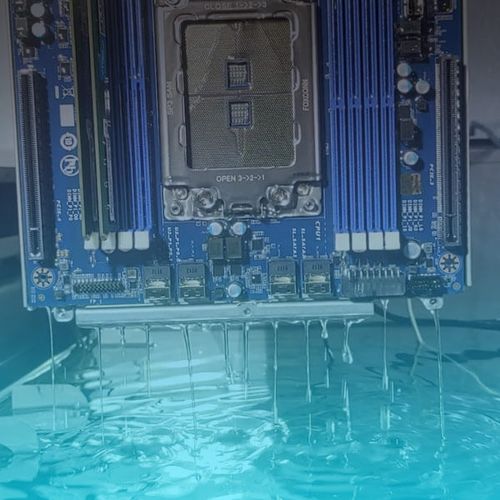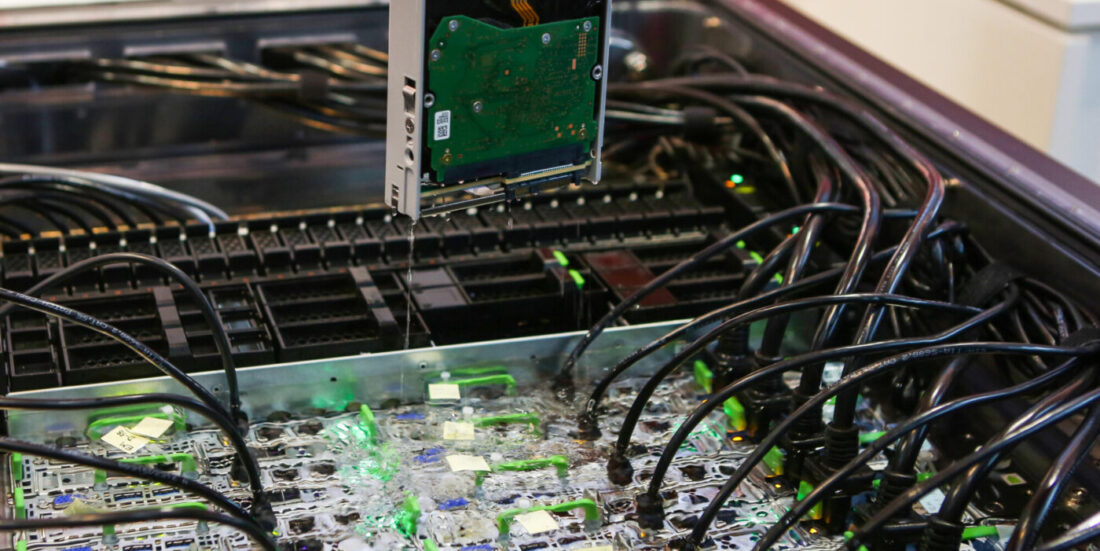Will computers of the future be submerged in liquid?
The need to cool down computers eats into the world’s energy consumption. By using liquid instead of air, we can save large amounts of energy and at the same time produce heat.
Computer cooling has become a major environmental culprits, not least due to developments in digitalization and artificial intelligence.
Computers produce heat and need to be cooled down in order to perform calculations accurately and avoid damage. Data centres spend 30-50 percent of their overall energy use on cooling their computers.
Liquid cooling offers an alternative solution.
“The main reason to consider a liquid solution is that liquids conduct heat 10 to 20 times better than air. It is also easier to retain the heat energy that is collected. The energy can be stored or used in district heating systems, for example,” says Paul Roger Leinan, a SINTEF research scientist.
Facts about the future of computing power:
- Artificial intelligence will drive a 165 percent increase in data centre power demand by 2030.3
- Data centre power consumption is expected to more than double by 2030.1
- In 2024, data centres used about 1.5 percent of the world’s total electricity.1
- By 2030, data centre power usage in the United States might account for as much as 9 percent of all electricity produced in the United States.5
- Today, 30 to 50 percent of the energy used by data centres goes to cooling.2, 3
Sources:
1) Data centres will use twice as much energy by 2030 — driven by AI, Nature, 2025, https://doi.org/10.1038/d41586-025-01113-z
5) https://www.epri.com/about/media-resources/press-release/q5vu86fr8tkxatfx8ihf1u48vw4r1dzf
Two liquid cooling options
Liquid cooling of computers is carried out in two main ways: either by directly cooling individual computer parts with water, or by immersing the entire computer using oil.
Direct cooling concentrates the cooling effect is where it is needed most. It usually takes place in a closed circuit with water, which is both cheap and best in terms of heat transfer. Its disadvantage is the complexity of the system, the risk of leaks and that the remaining computer components must be cooled off using other methods, like air cooling.
Immersion cooling offers other possibilities. This method immerses the entire computer or electrical components in a bath that then flows over and through the electrical components.
“We used calculations to show how to achieve a uniform flow of coolant throughout the entire tank, so that all parts of the computer receive sufficient cooling.”
“With this method, we use a dielectric coolant that does not conduct electricity. The advantage is that all the components in the computer are cooled with the same system,” says Leinan.

Immersion cooling submerges the entire computer or electrical parts in a bath of oil-based fluid. Photo: Coolblock by Synapsecom (www.coolblock.com)
Most efficient cooling possible
Liquid cooling is not a new technology, but because today’s computers and server farms are so powerful, the technology is experiencing a new upswing.
SINTEF is now working on immersion cooling as part of the EU MODERATOR project. The scientists calculate and measure the technology using mathematical simulation tools, laboratory experiments and advanced techniques.
“We used calculations to show how to achieve a uniform flow of coolant throughout the entire tank, so that all parts of the computer receive sufficient cooling,” Leinan says.
“We’ve tested systems that can measure both low speeds of the liquid flow and small temperature changes. This allows us to test cooling solutions very accurately.”
The heat can be used for other purposes
With liquid cooling, the heat from the computer is transferred to the liquid and is then transported with it out of the cooling tank, where it can then be released, stored or sent on.
“The temperature from such centres, at 50-70 degrees, is very useful for heating buildings and some types of industry and facilities. The relatively low temperature means that the heat can be transported long distances or stored for a long time, with little heat loss or the need for insulation.
Currently, immersion cooling is most relevant for small and medium-sized data centres. The reason for this is that the technology can be used by these centres with only minor adaptations, and the heat released from the cooling can be more easily used by others.
Combine both technologies?
The researchers found that the most promising cooling solutions will likely combine principles from both direct cooling of individual parts and from immersion cooling.
“A lot of components in computers need cooling, but some of the parts need significantly more cooling power than others, like the processors that perform calculations in a computer,” says Leinan.
It is also important to choose the right materials for the inside of the servers. The cooling oil can dissolve some plastic materials, which can reduce the lifespan of server components, according to f the scientists behind the study.




